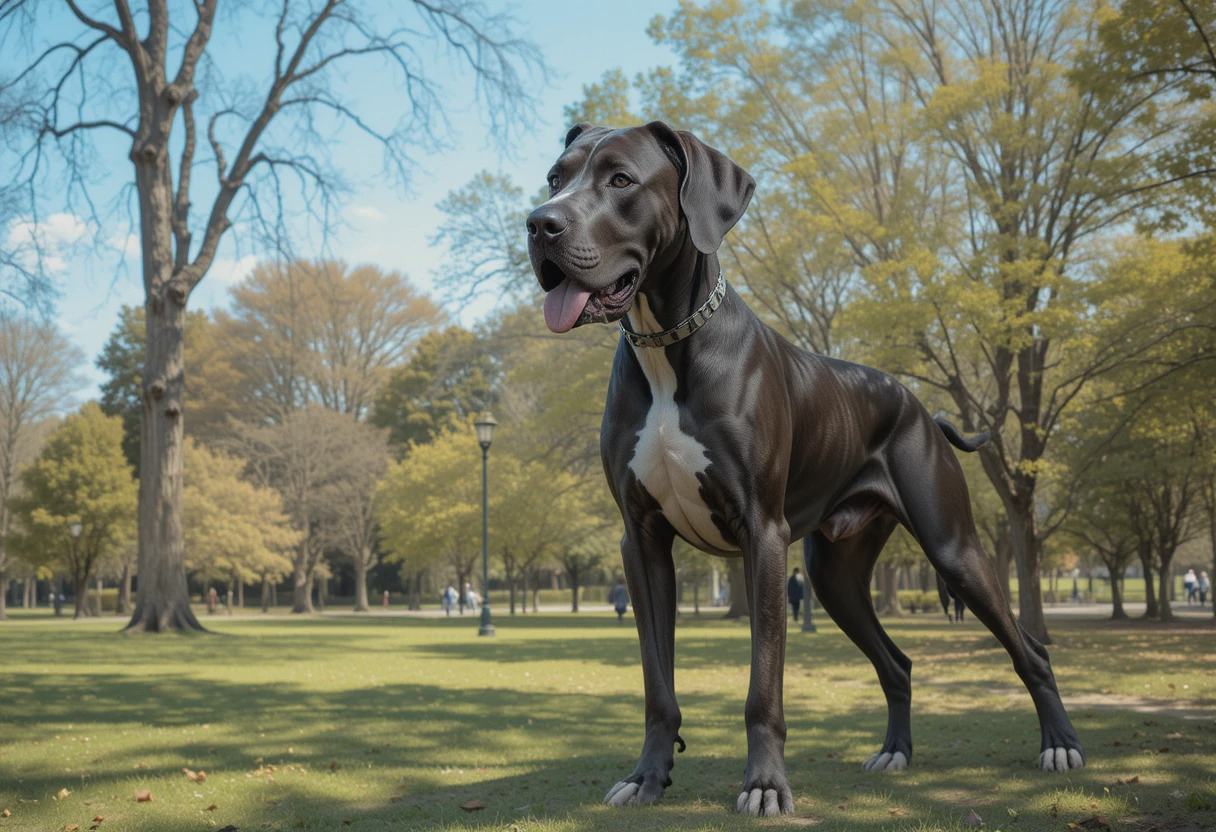The merle Great Dane stands as one of the most visually striking and genetically fascinating variations of the beloved gentle giant breed. With their distinctive mottled coat patterns featuring irregular patches of dark pigment against lighter backgrounds, these magnificent dogs have captured the hearts of canine enthusiasts worldwide.
However, beneath their stunning appearance lies a complex genetic story that every potential owner should understand.
This comprehensive guide will take you through everything you need to know about merle Great Danes, from their unique genetics and health considerations to care requirements and temperament traits.
Whether you’re considering adding one to your family or simply curious about this remarkable color variation, you’ll find valuable insights backed by current research and expert knowledge.
Understanding the Merle Great Dane: A Historical Perspective
Merle Great Danes have always existed within the breed, but their journey to recognition has been anything but straightforward. For over a century, merle was actually a disqualification in dog shows, meaning these beautiful dogs couldn’t compete regardless of their exceptional conformation or temperament Purina Pro Club.
The turning point came when groundbreaking research revealed that merle is actually essential for producing harlequin Great Danes—one of the most prized color patterns in the breed.
This discovery led to the American Kennel Club officially recognizing merle as an approved color on January 1, 2019. In April 2019, history was made when Bellini (CH Dulce Put a Cork In It) became the first merle Great Dane to earn a conformation champion title.
The Science Behind Merle Great Dane Genetics
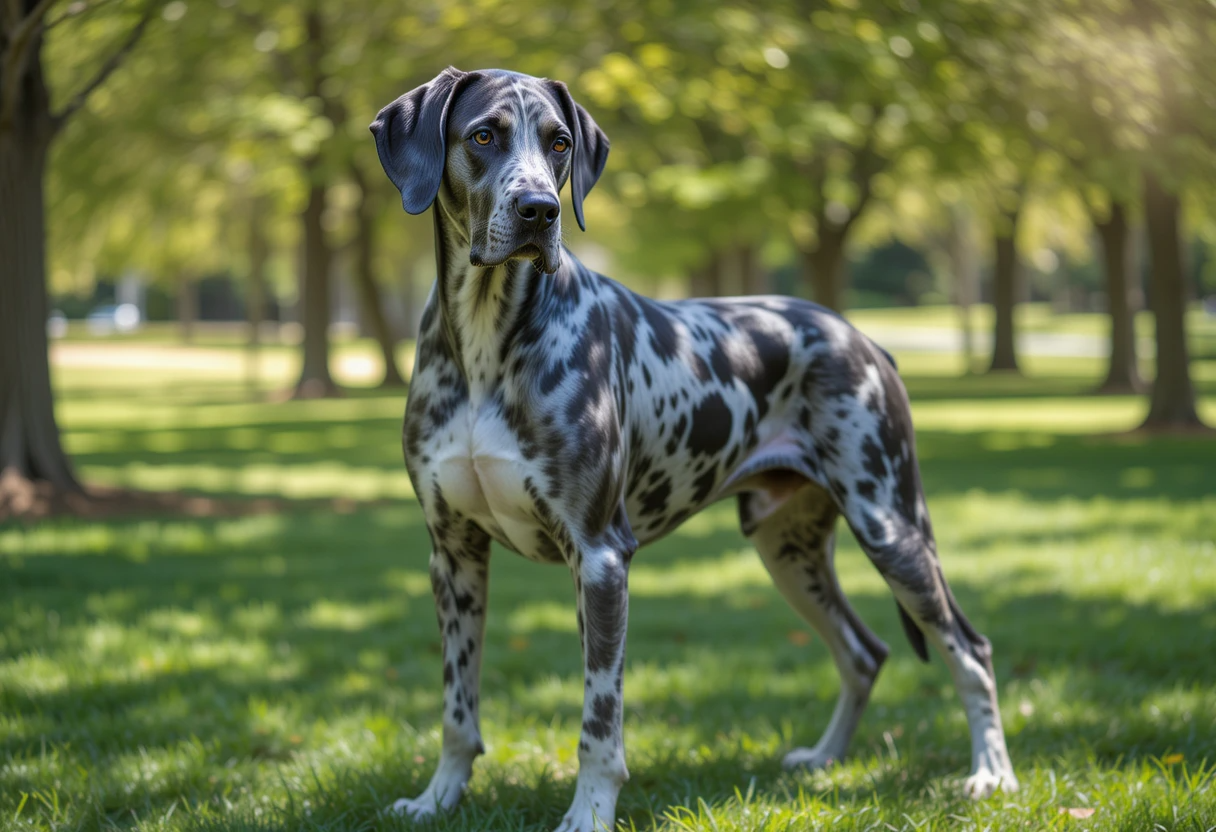
How the Merle Gene Works
The merle pattern results from a fascinating genetic mechanism involving the SILV gene (also called PMEL17). This gene is responsible for producing a matrix within pigment cells that holds pigment granules in place. When a dog carries one copy of the merle allele (M) and one non-merle allele (m), creating an Mm genotype, the matrix becomes incomplete with holes that allow pigment granules to escape, resulting in the characteristic diluted patches American Kennel Club.
The genetics become even more complex when we consider that the genetic insertion creating merle is unstable and tends to change size during embryonic development. Recent research has identified different types of merle based on insertion length:
- Cryptic merles (25-44 base pairs): No obvious merle pattern visible
- Dilute merles (66-74 base pairs): Uniformly diluted coat without distinct patches
- Normal merles (78-86 base pairs): Classic mosaic pattern typical of most merle Great Danes
- Harlequin merles (81-105 base pairs): Large white areas with fully pigmented patches
The Merle-Harlequin Connection
One of the most significant discoveries in Great Dane genetics is the relationship between merle and harlequin patterns. Research conducted at Texas A&M University and later at Clemson University conclusively proved that harlequin is actually a modification of merle, controlled by a dominant H gene that removes dilute pigment and increases the size of fully pigmented regions Purina Pro Club.
This means that all harlequin Great Danes carry at least one merle allele, making merle an integral part of harlequin breeding programs. The research also explained why harlequin-to-harlequin matings often produce smaller litters—the HH genotype likely causes embryonic death early in pregnancy.
Check out our guide on the Top 10 Easiest Puppies to Train for Beginners in 2025.
Physical Characteristics of Merle Great Danes
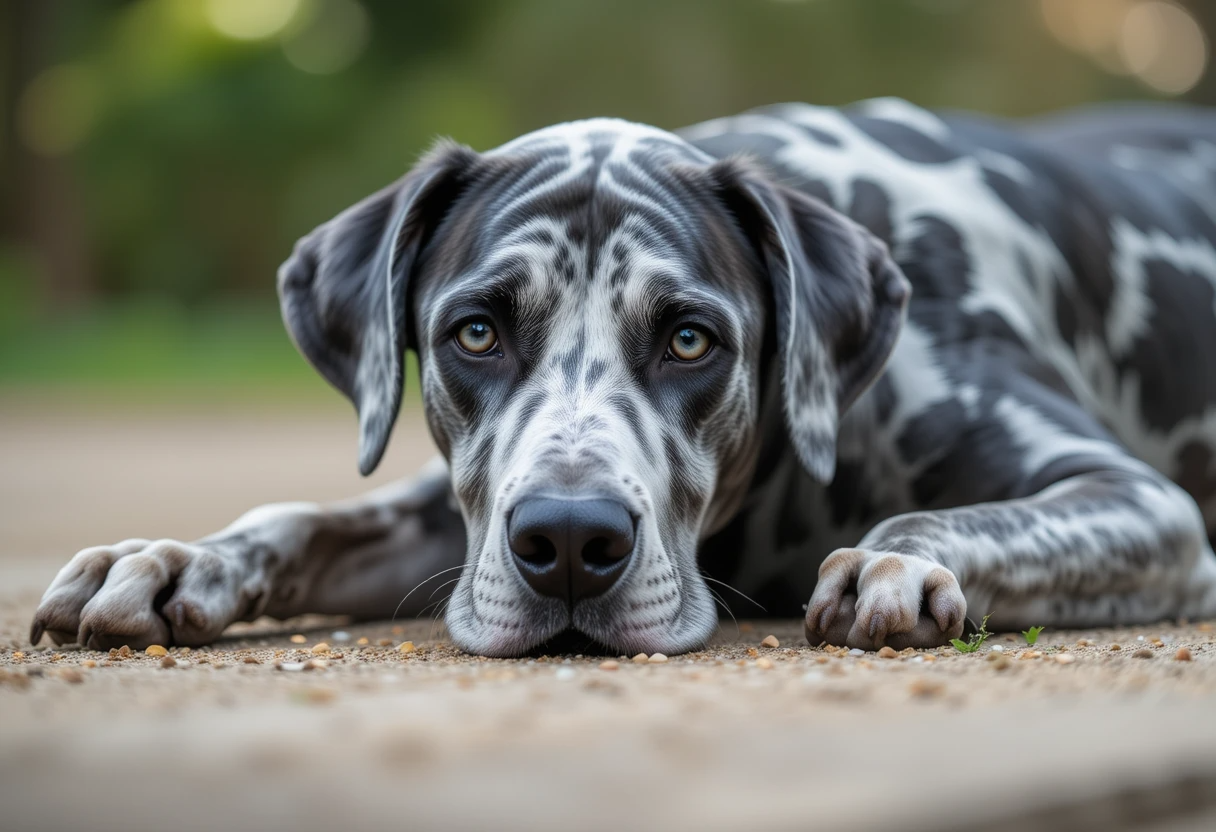
Coat Pattern and Coloration
Merle Great Danes display a distinctive coat pattern characterized by:
- Base color: Light to dark gray background
- Pattern: Irregular dark gray or black patches of varying sizes
- Texture: Same smooth, short coat as other Great Danes
- Eye color: Often blue or partially blue eyes, though brown eyes are also possible
- Size variations: Patches can range from small speckles to large irregular blotches
The merle pattern is never exactly the same on any two dogs, making each merle Great Dane truly unique. Some may have extensive merling throughout their coat, while others might show the pattern primarily on specific areas like the face or legs.
Size and Build
Merle Great Danes maintain the same impressive size standards as other Great Dane color variations:
- Males: 30-32 inches tall, 140-175 pounds
- Females: 28-30 inches tall, 110-140 pounds
- Build: Well-balanced, elegant, and powerful
- Proportion: Square outline with equal height and length
The merle gene affects only coat coloration and has no impact on the dog’s size, structure, or physical capabilities.
Health Considerations for Merle Great Danes
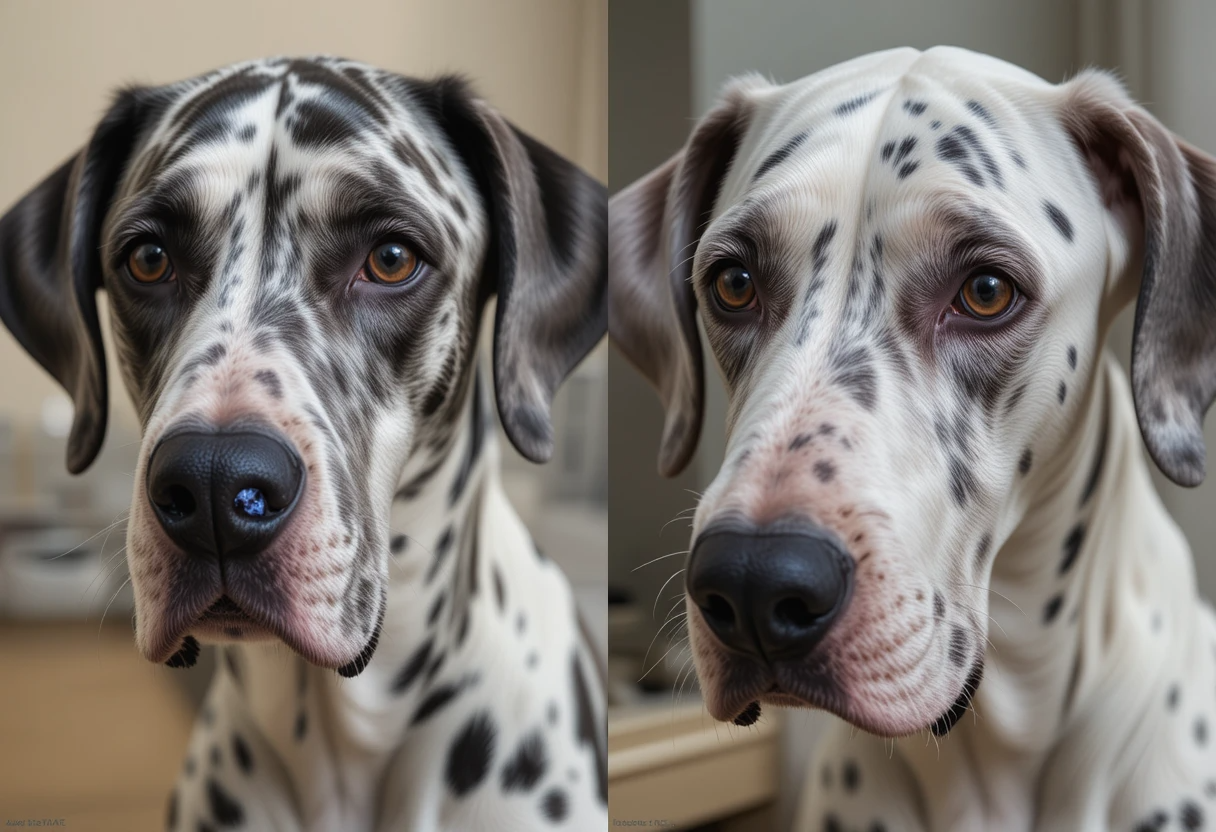
Single Merle Health Profile
Single merle Great Danes (Mm genotype) are generally as healthy as any other Great Dane color variation. The presence of one merle allele does not inherently cause health problems, and these dogs can live full, healthy lives with proper care SpiritDog Training.
However, like all Great Danes, they remain susceptible to breed-specific health issues including:
- Bloat and Gastric Dilatation Volvulus (GDV)
- Hip dysplasia
- Cardiomyopathy
- Wobbler syndrome
- Osteosarcoma
The Double Merle Problem
The serious health concerns arise with double merle Great Danes (MM genotype), which result from breeding two merle dogs together. These dogs face significantly increased risks of:
Hearing Impairments:
- Studies show approximately 25% of double merles experience some degree of hearing loss
- 10% are unilaterally deaf (one ear)
- 15% are bilaterally deaf (both ears)
Vision Problems:
- Nearly 100% of double merles have some degree of eye abnormalities
- Microphthalmia (abnormally small eyes)
- Misshapen or off-center pupils
- Potential blindness or severe vision impairment
Physical Characteristics:
- Predominantly white coat with minimal color patches
- Increased sensitivity to sunlight
- Potential skin issues in unpigmented areas
Responsible Breeding Practices
Ethical breeders never intentionally breed two merle dogs together due to the high risk of producing double merles. In some countries like Germany, such breeding practices are actually illegal. Instead, responsible breeders typically pair merle Great Danes with solid-colored dogs to maintain genetic diversity while avoiding double merle offspring.
Want your puppy to sleep peacefully? Check out our guide on Kennel Training Puppy at Night: Quick & Easy Tips for Fast Results to get started the right way.
Temperament and Personality of Merle Great Danes
Classic Great Dane Temperament
Merle Great Danes possess the same wonderful temperament characteristics that make Great Danes beloved family companions. The merle gene affects only coat color and has no bearing on personality traits.
Key Temperament Traits:
- Gentle and affectionate: True to their “gentle giant” reputation
- Patient and calm: Excellent with children when properly socialized
- Loyal and devoted: Form strong bonds with their families
- Intelligent and trainable: Respond well to positive reinforcement
- Alert but not aggressive: Make excellent watchdogs without unnecessary aggression
Socialization and Early Training
Like all Great Danes, merle individuals benefit tremendously from early socialization and training. Their large size makes proper training essential for everyone’s safety and comfort. Key focus areas include:
Essential Training Commands:
- Sit and stay (crucial for a 150+ pound dog)
- Proper leash walking
- “Off” command for jumping
- Recall training
- Basic obedience
Socialization Priorities:
- Exposure to various people, animals, and environments
- Positive interactions with children
- Habituation to different sounds and situations
- Car travel training
- Veterinary handling preparation
Caring for Your Merle Great Dane
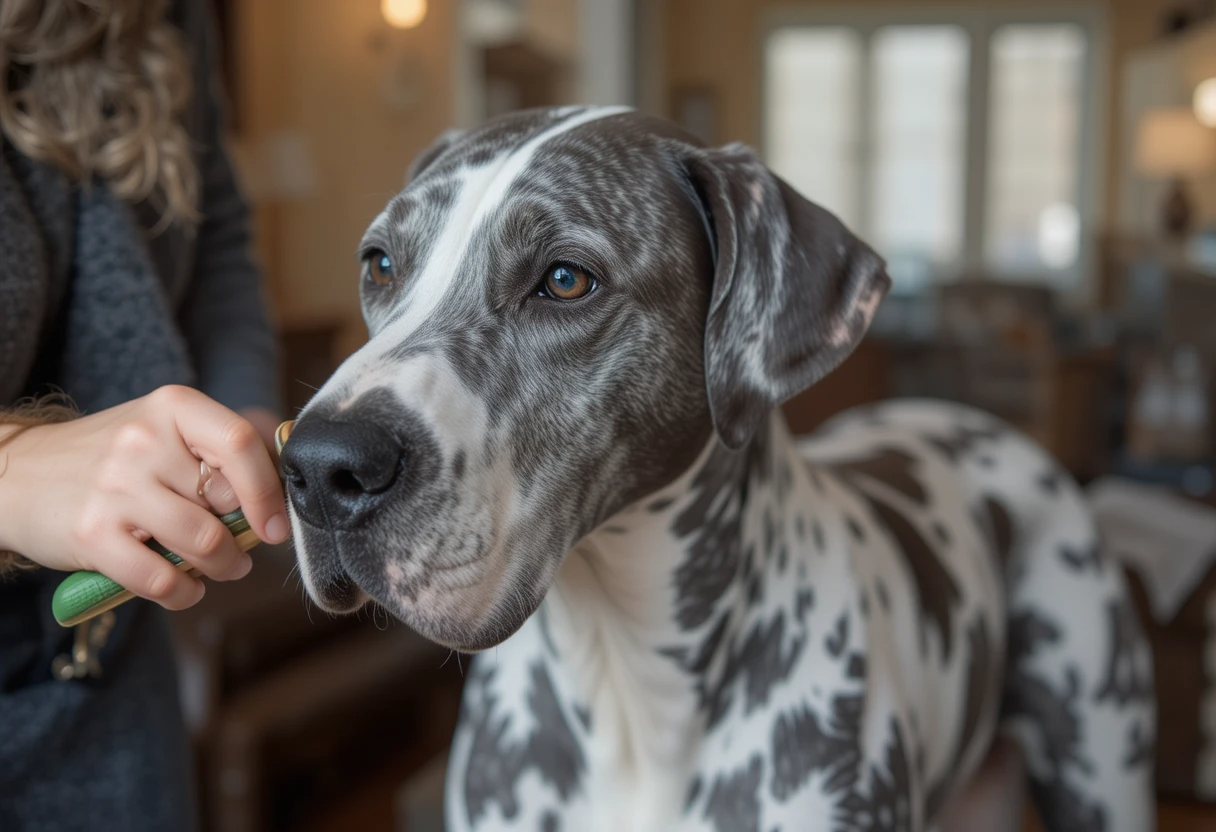
Nutritional Requirements
Merle Great Danes have the same nutritional needs as other Great Danes, with special considerations for their rapid growth and large adult size:
Puppy Nutrition (0-18 months):
- Large breed puppy formula with controlled calcium levels
- Multiple small meals (3-4 times daily)
- Avoid over-supplementation
- Monitor growth rate to prevent developmental orthopedic diseases
Adult Nutrition:
- High-quality protein (22-26% for adults)
- Controlled fat content (12-15%)
- Two smaller meals daily to reduce bloat risk
- Elevated feeding bowls for comfort
Exercise and Activity Needs
While merle Great Danes require regular exercise, their needs are more moderate than many people expect:
Exercise Guidelines:
- Puppies: Short, gentle walks and play sessions
- Adults: 30-60 minutes of moderate exercise daily
- Preferred activities: Leashed walks, supervised play, mental stimulation games
- Avoid: Excessive running or jumping, especially during growth phases
Grooming and Coat Care
The merle coat requires minimal special care:
Regular Grooming Routine:
- Weekly brushing with a rubber curry brush
- Occasional baths as needed
- Regular nail trimming
- Ear cleaning and dental care
- Seasonal shedding management
Sun Protection Considerations: While not as critical as for double merles, providing shade and limiting excessive sun exposure can help protect the lighter-pigmented areas of the merle coat. Learn more about the most loyal Pitbull breeds.
Finding a Reputable Merle Great Dane Breeder
What to Look For
When searching for a merle Great Dane, finding an ethical, knowledgeable breeder is crucial:
Essential Breeder Qualities:
- Extensive knowledge of merle genetics
- Never breeds merle to merle
- Provides genetic testing results
- Health testing of parent dogs
- Transparent about breeding practices
- Lifetime support commitment
Required Health Testing:
- Hip and elbow dysplasia screening
- Cardiac examination
- Eye examination
- Genetic testing for coat color
- Thyroid function testing
Cost Considerations
Merle Great Dane prices typically range from $1,800 to $3,500, depending on factors such as:
- Breeder reputation and location
- Parent dogs’ quality and titles
- Health testing completeness
- Regional demand
- Specific merle pattern characteristics
Remember that the initial purchase price is only the beginning—lifetime costs including food, veterinary care, and potential health issues can easily reach $15,000-$25,000 or more.
Red Flags to Avoid
Warning Signs of Irresponsible Breeding:
- Breeding merle to merle
- Multiple litters available simultaneously
- No health testing documentation
- Unwillingness to meet parent dogs
- Pressure for quick sales
- Unusually low or high prices
- Claims of “rare” or “exotic” colors
Training Your Merle Great Dane
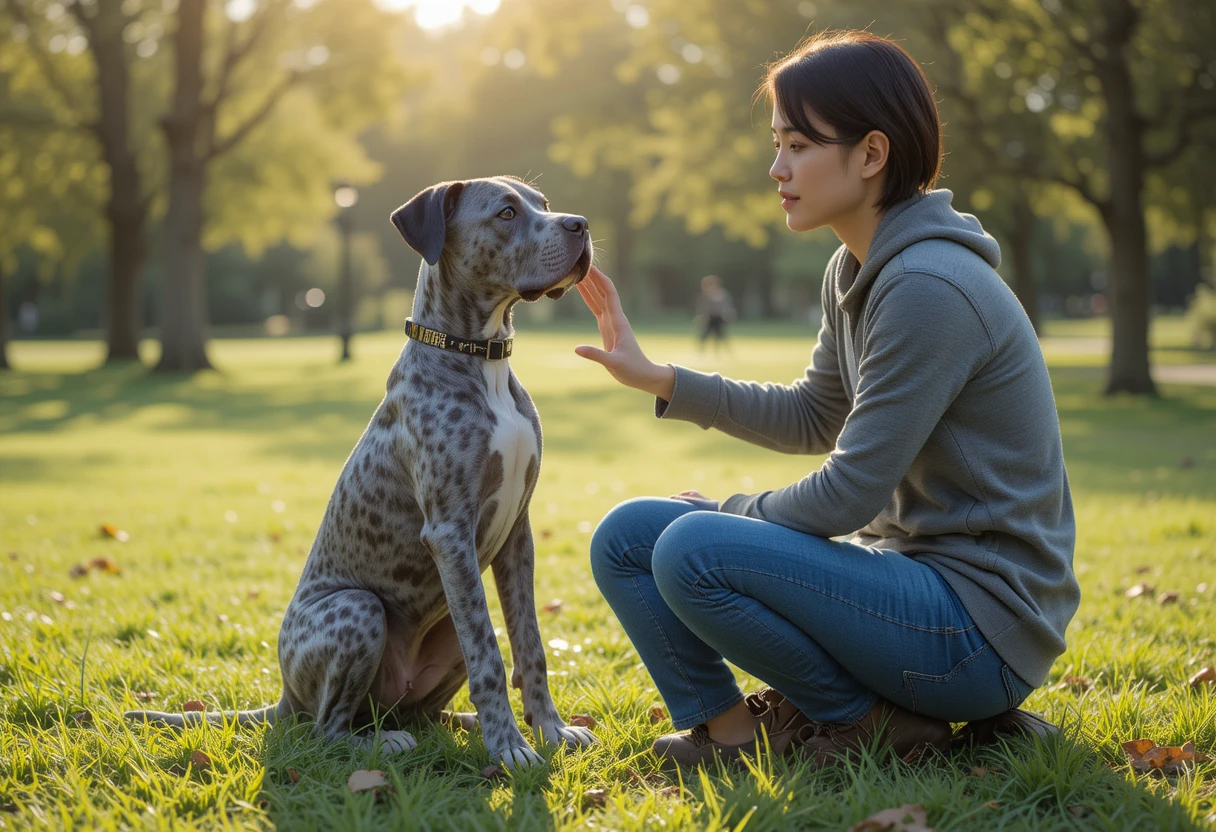
Early Puppy Training
Starting training early is essential for merle Great Dane puppies:
8-12 Weeks:
- Basic housetraining
- Crate training introduction
- Name recognition
- Gentle handling exercises
3-6 Months:
- Basic obedience commands
- Leash training
- Socialization experiences
- Bite inhibition
Advanced Training Considerations
Positive Reinforcement Methods:
- Food-motivated training works well
- Keep sessions short (5-10 minutes)
- Focus on consistency
- Avoid harsh corrections due to sensitive nature
Common Training Challenges:
- Size-related handling issues
- Counter surfing prevention
- Gentle mouth training
- Proper greeting behaviors
Living with a Merle Great Dane
Housing Requirements
Space Considerations:
- Adequate indoor space for a giant breed
- Secure fencing (6+ feet recommended)
- Comfortable sleeping area
- Temperature control (sensitive to extremes)
Family Integration:
- Supervision with small children initially
- Proper introduction to other pets
- Establishment of household rules
- Consistent routine implementation
Long-term Commitment
Owning a merle Great Dane represents a significant 8-10 year commitment involving:
Financial Responsibilities:
- Higher food costs due to size
- Increased veterinary expenses
- Potential specialized equipment needs
- Emergency medical fund
Lifestyle Adjustments:
- Travel planning considerations
- Home modification needs
- Exercise scheduling
- Social responsibility awareness
FAQs
Single merle Great Danes (Mm genotype) are generally as healthy as any other Great Dane color variation. The merle gene itself doesn’t cause health problems when present in single copy. However, double merles (MM genotype) from merle-to-merle breeding can have serious health issues including deafness and blindness. Are merle Great Danes healthy?
How much do merle Great Danes cost?
Merle Great Dane puppies typically cost between $1,800-$3,500, depending on the breeder’s reputation, location, and the dog’s lineage. Some exceptional examples from champion bloodlines may cost more. Remember to budget for lifetime expenses which can exceed $20,000.
Can you breed two merle Great Danes together?
No, responsible breeders never breed two merle Great Danes together due to the high risk of producing double merle puppies with serious health problems. This practice is considered unethical and is illegal in some countries like Germany.
What is the lifespan of a merle Great Dane?
Merle Great Danes have the same lifespan as other Great Dane color variations, typically 8-10 years, with some living 6-7 years and lucky individuals reaching 12 years. Their lifespan is primarily influenced by their giant breed status rather than coat color.
Do merle Great Danes have different temperaments?
No, the merle gene affects only coat coloration and has no impact on temperament. Merle Great Danes possess the same gentle, affectionate, and loyal personality traits that make Great Danes excellent family companions.
If you’re fascinated by unique dog breeds, don’t miss our guide on the Top 10 Most Popular Japanese Dog Breeds Everyone Loves.
Conclusion
Merle Great Danes represent a stunning example of canine genetics at work, combining breathtaking beauty with the beloved gentle giant temperament that makes Great Danes such cherished companions. Their journey from disqualified color to recognized breed variation illustrates how scientific understanding can reshape our appreciation of genetic diversity.
For those considering adding a merle Great Dane to their family, the key lies in education and preparation. Understanding the genetics, finding responsible breeders, and committing to proper care ensures these magnificent dogs can thrive as beloved family members. While their striking appearance may initially draw attention, it’s their gentle souls and loyal hearts that create lasting bonds.
The future of merle Great Danes looks bright, with improved genetic testing helping responsible breeders make informed decisions while maintaining the health and welfare of these remarkable dogs. As our understanding of canine genetics continues to evolve, we can appreciate both the beauty and complexity that makes each merle Great Dane truly unique.
Whether gracing a show ring or serving as a cherished family guardian, merle Great Danes continue to exemplify the perfect blend of elegance, gentleness, and genetic fascination that defines one of the world’s most beloved giant breeds.
If you’re struggling with constant whining after crate time, don’t miss our guide on Why Is Your Puppy Whining in Crate Nonstop After You Leave, where we explain the top reasons and how to fix them.
